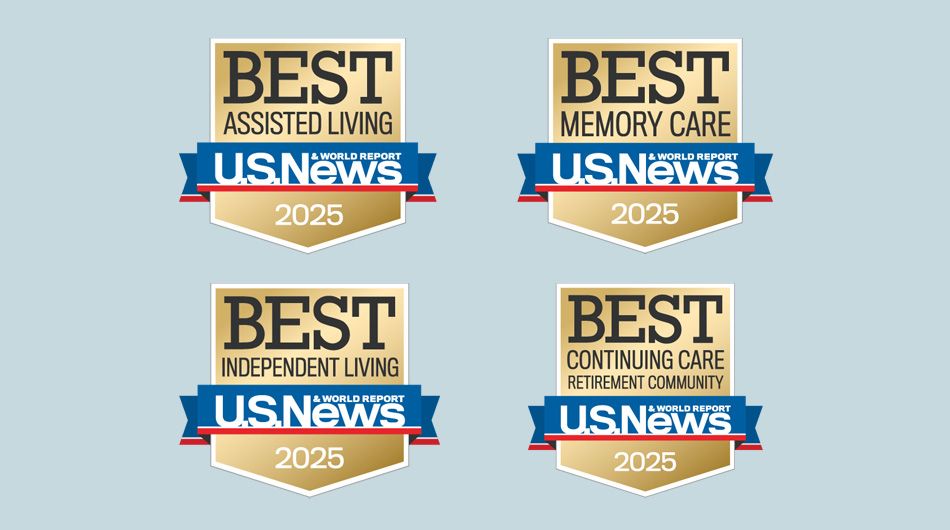Staff appreciation and recognition received the lowest satisfaction score for those working in the long-term and post-acute care industry. As customers are most satisfied with your care staff’s ability, for the first time in years, saying “thank you” has never been more detrimental to your staff’s retention rate.
Employee recognition received the lowest satisfaction score from care staff in the long-term and post-acute care industry, according to the 2024 Activated Insights Benchmarking Report.
Contrastingly, customers ranked their care staff’s ability as their highest satisfaction score.
Meaning your care staff are your company’s best attribute, and they don’t know it.
As communication from provider has been a main point of concern for both employees and customers for years, those who practice gratitude in the workplace will see both improved satisfaction and retention rates.
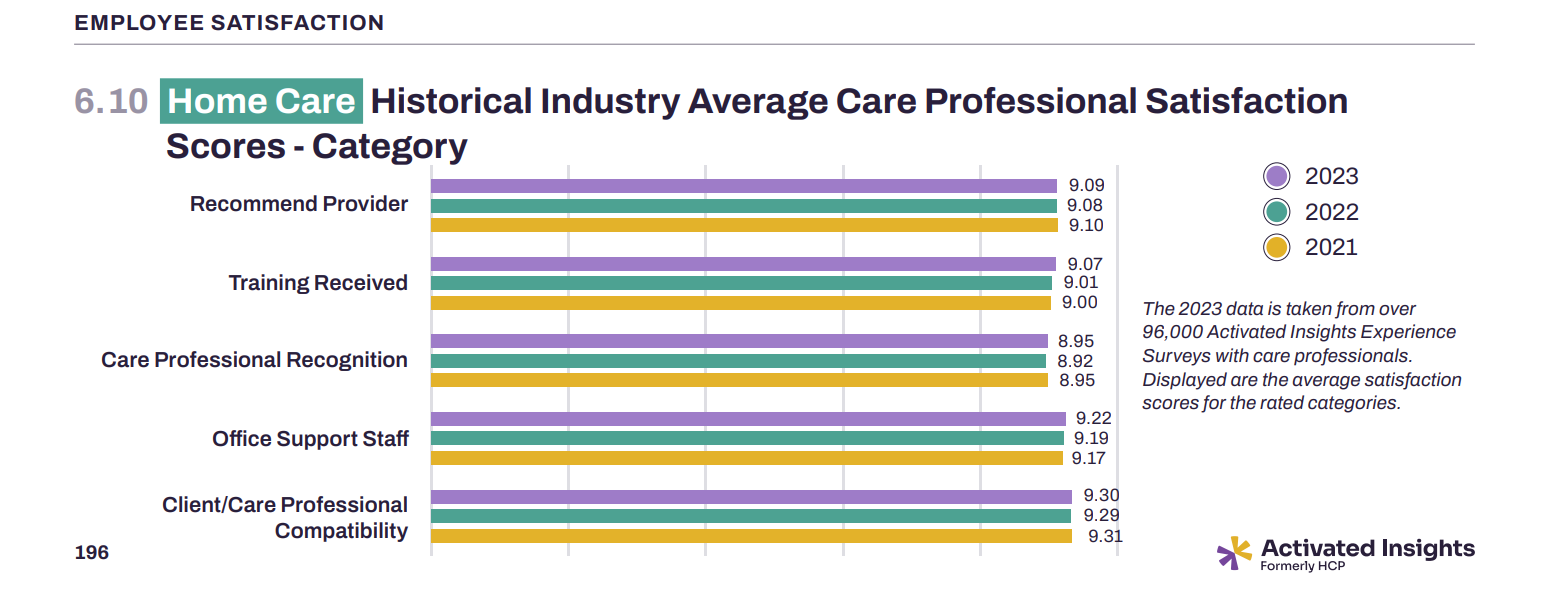
Transform your workplace culture from thankful to thriving with these 10 data-driven strategies to show appreciation to your employees.
Staff Appreciation Strategy #1: Say “Thank You” Using Real Customer Feedback
It’s not easy caring for strangers during their most vulnerable times of life. Care staff who empower their customers to feel like a friend, and not just a job, deserve to hear how their efforts are impacting the lives of those they care for and serve.
How to Execute: Illustrate your care staff’s impact on the lives of those in their care by gathering feedback from your customers.
Surveying your customers using a third party not only creates a safe space for them to share their thoughts about your company, ultimately revealing your blind spots, but it also serves as an opportunity to hear their favorite parts about utilizing your services. Too often, we can focus on gathering and acting on negative feedback. While important, gathering and acting on the positive feedback by communicating it back to your staff will ripple its effects throughout your staff’s retention rates, satisfaction levels, and overall company revenue.
Staff Appreciation Strategy #2: Extend Gratitude Towards Your Office Staff
As a provider in the caring industry, it’s easy to focus on the caregivers who make it all possible. But just like a stage performance, the production wouldn’t be possible without the backstage crew working behind-the-scenes.
Research shows that for every 1 scheduler who quits, 4 care staff will leave with them. According to our calculations and the Center for American Progress, it costs an average of $3,900 to replace a single care employee and $7,840 to replace an administrative staff member. This means that losing one scheduler to preventable burnout could cost your agency around $23,440.
In other words, making sure your office staff feel appreciated is an investment worth making.
How to Execute: Nurture the relationship between care and office staff by ensuring your office staff are recognized companywide.
Staff Appreciation Strategy #3: Actively Invest in Your Staff’s Potential
Caregiving in the long-term and post-acute care industry has a bad rap for being a dead-end job, when the truth is, it’s the exact opposite—if executed right by the employer.
No matter the skill level, candidates can find a place for employment within at least one sector of the long-term and post-acute care industry and work their way up. For example, as over half of all HBC staff enter the field with no formal education past high school, their employment with you may be your staff’s only opportunity to climb the career ladder.
How to Execute: Prioritize building a career ladder where staff can specialize in their own interests and actively promote these advancement opportunities within your company.
Allowing your staff to specialize in their own interests empowers them to find the niche where they thrive while feeling like they were worth the investment in your company. Plus, providers with clear career ladders have proven increased satisfaction and retention rates among both staff and customers.
Staff Appreciation Strategy #4: Take Initiative Towards Easing Your Employee’s Burdens
According to a 2024 study done by Public Health Information, a stunning 37% of direct care workers live in a low-income household.
For those who are already living from paycheck-to-paycheck, the bi-weekly payroll model may be causing unnecessary strain on your employees when the fact of the matter is that switching how your company handles payroll is a quick and easy fix that will pay dividends in ROI for your staff.
How to Execute: Anticipate your staff’s financial needs by adjusting your current biweekly payroll systems to offer payment options like weekly or daily pay. Offering daily pay in this industry is proven to incentivize future employees of similar demographic to work for your company, compared to competitors in the space, as it offers greater financial flexibility and security.
“Companies have seen on average a 50% reduction of annualized turnover among the population of daily pay users. The story is very clear: daily pay is a benefit that caregivers are willing to stay for.”
Staff Appreciation Strategy #5: Show, Don’t Just Tell, Your Appreciation
In a recent Professional Love Language Activated Insights webinar, attendees were taught that not every employee feels appreciation in the same way. The way you’re thanking your employees may not be resonating with them.
One of the five professional love languages is receiving gifts, a small and surefire way to express gratitude towards your staff, especially around the holidays.
In an online forum for business owners in the industry, providers shared ideas for how they expressed gratitude towards their staff. Here are a few ideas to get you started, whether it be for a holiday, or just because:
Jessica Nobles, with Home Care Ops delivered pies to her caregivers on Thanksgiving and reaped the satisfaction of service. A simple pie inspired multiple caregivers to personally text and thank her for the thoughtful hand-delivered gesture.
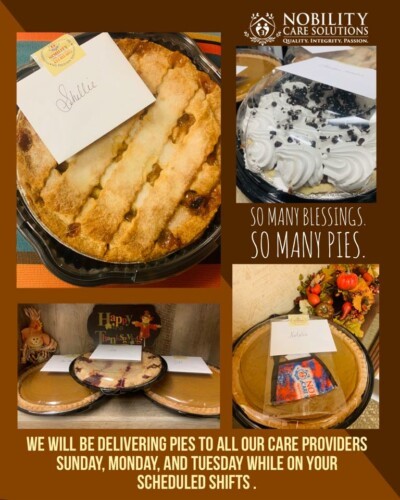
Saving your caregivers’ time in the kitchen this holiday season doesn’t have to break the bank. Pre-order pies a week in advance from your local grocery store to participate in the holiday traditions as a team.
Felicia Woolcock, at Majestic Sunshine Care, packed her trunk full of turkeys around the holidays and hand-delivered them to her employees’ homes.

Kelly Smith Britton, at Always Best Care Senior Services, supplied each of their care staff with a gift card to help cover the cost of a holiday dinner or a few items off their grocery list.
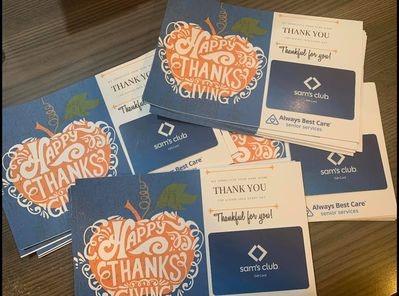
Whether you decide to hand out turkeys or gift cards, your staff will appreciate how you took time to take care of their needs outside of work.
Kathy Jordan Uveges, at Seniors Helping Seniors, surprised her care staff with notes of appreciation. If you recall a moment where you were impressed with an employee’s actions, write a quick note to show that their service not only matters to the company, but is in fact the very reason you began working in long-term and post-acute care.


How to Execute: Prepare small tokens of your appreciation, particularly around the holiday season, then measure your staff’s satisfaction and performance levels after practicing it consistently.
Make “the extra mile” the first mile you take when it comes to preparing small gifts of appreciation for your staff. Not only will it help speak to those with the gifting professional love language, but it will serve as a tangible reminder for your employees that they are thought of and appreciated at work.
Staff Appreciation Strategy #6: Recognize Important Employee Milestones
In the long-term and post-acute care industry, there is a crucial milestone that indicates imminent turnover compared to any other industry in the United States. While the typical turnover rate for new employees is about two years, it’s 100 days in the long-term and post-acute care industry.
Why is that? Because crucial little milestones along the way are going unappreciated and unacknowledged, leaving staff feeling unvalued and underprepared.
How to Execute: Personally check in with your staff at crucial employment milestones like first day on the job, first 30 days, and first 100 days to prove that your employees are more than just a number. Take a person-centered leadership approach by demonstrating that you care about the important times in your staff’s lives, like work anniversaries or birthdays.

Staff Appreciation Strategy #7: Implement An Employee Recognition Program
Since care staff recognition is the top complaint among care employees this year, consider creating a program dedicated to providing consistency and order behind meeting your staff’s expectations for appreciation. Your company’s employee recognition program should be used as an opportunity to highlight outstanding performance, such as “Employee of the Month,” get to know the staff posts on social media, or shout-outs in meetings.
How to Execute: Gather feedback to learn how your staff would like to be recognized and implement those takeaways into an Employee Recognition Program.
Staff Appreciation Strategy #8: Involve Staff in Company-Wide Decision Making
Data in the 2024 Activated Insights Benchmarking Report shows that involving your staff in decisions that affect them pays off. For example, care staff are most satisfied by their customer to employee care plan matching. For years, providers have been grappling with the task of assigning the right employee to the right customer, and for years, it’s been a top complaint for both employees and customers. Until recently when providers started using the knowledge of those who had worked out in the field to do the care plan matching for them. For example, like a care employee who became an office employee.
How to Execute: When applicable, involve your staff in company-wide decisions to demonstrate that they are irreplaceable and have invaluable input.
Staff Appreciation Strategy #9: Provide Resources, Reimbursements, and Rest
Does your staff feel like they’re a part of a team? Just like any sports team, each member is vital to the success of the game. Consider providing your staff with matching items like swag or scrubs that make them feel a part of your company’s bigger picture and communicate unity to your customers.
Albeit fulfilling, caregiving is a physically and mentally taxing job. As a result, does your staff have access to the resources they need to take care of themselves? Offering training on self-care courses such as: Stress Management Skills, Personal Wellness, Taking Care of Your Back, and Grieving With and For Your Clients.
How to Execute: Transform your leadership from provider to coach as you treat your staff like a team. Ensure they have the necessary resources and care support to perform their jobs effectively such as self-care training to alleviate stress and improve job satisfaction.
Staff Appreciation Strategy #10: Recognize Your Company as A Whole Unit
At the beginning of this presentation, we talked about how employee recognition was the number one complaint, or lowest satisfaction score, from employees in the long-term and post-acute care industry last year. Implementing these strategies takes you one step closer towards changing that for good, so why not get all your employees’ hard work recognized as a whole?
How to Execute: Recognize your employees’ hard work as a whole entity, such as earning Great Place To Work® Certification ™.
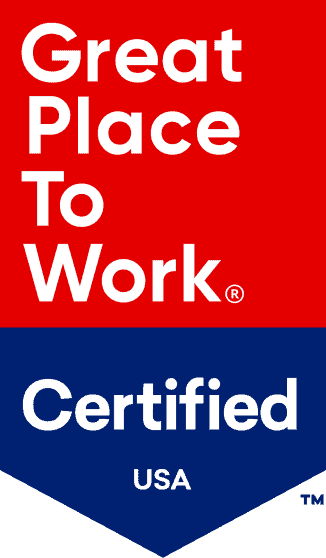
From Thankful to Thriving
As Activated Insights CEO, Bud Meadows says, “Catch someone doing something good.” According to a study done by US News, Americans only say thank you one in seven times when the situation warrants it.
Practicing gratitude at work, especially as an employer, is a mindset shift. It’s an opportunity to grow from an employer to a leader, to a respected culture influencer.
Lastly, thank YOU for taking the time to read up on how to improve the lives of your employees.
Related Posts













